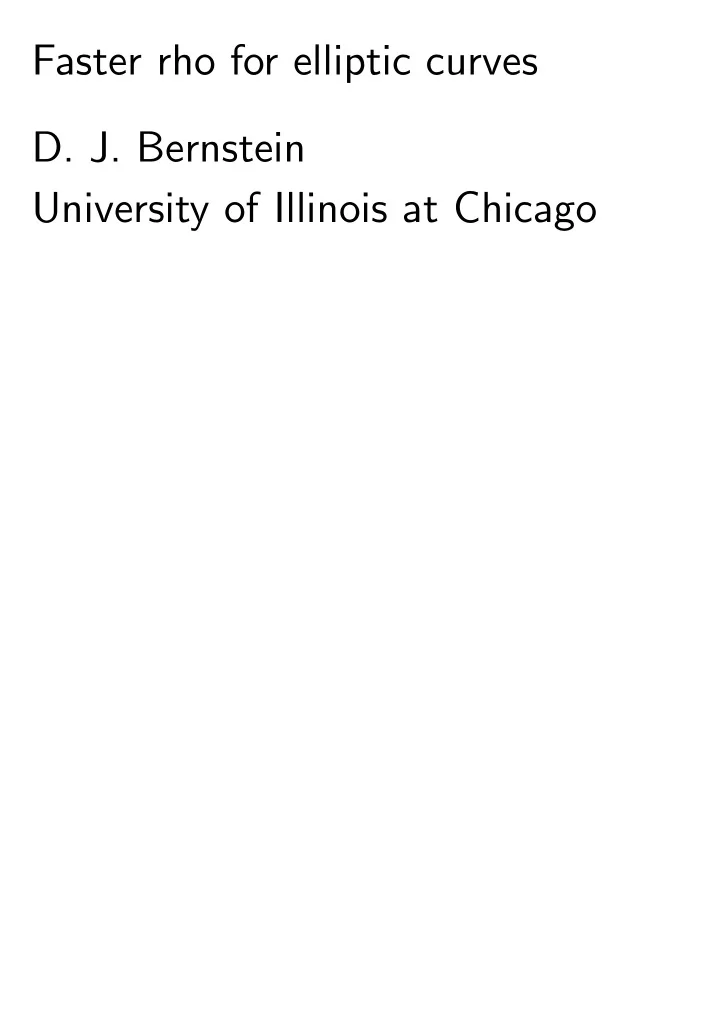

Faster rho for elliptic curves D. J. Bernstein University of Illinois at Chicago
“Breaking ECC2K-130”, joint work by many authors: ECDL attack in progress against Koblitz curve over F 2 131 using many CPUs, GPUs, FPGAs. Vertically integrated stack of new techniques for optimizing choice of rho iteration function, computation of iteration function, underlying binary-field arithmetic. Also new improvements in rho communication volume.
“Breaking ECC2K-130”, joint work by many authors: ECDL attack in progress against Koblitz curve over F 2 131 using many CPUs, GPUs, FPGAs. Vertically integrated stack of new techniques for optimizing choice of rho iteration function, computation of iteration function, underlying binary-field arithmetic. Also new improvements in rho communication volume. But I’m actually going to talk about something else.
Previous ECDL attack: 2009.07 Bos–Kaihara– Kleinjung–Lenstra–Montgomery “PlayStation 3 computing breaks 2 60 barrier: 112-bit prime ECDLP solved”. Successful ECDL computation for a standard curve over F ♣ where ♣ = (2 128 � 3) ❂ (11 ✁ 6949).
Previous ECDL attack: 2009.07 Bos–Kaihara– Kleinjung–Lenstra–Montgomery “PlayStation 3 computing breaks 2 60 barrier: 112-bit prime ECDLP solved”. Successful ECDL computation for a standard curve over F ♣ where ♣ = (2 128 � 3) ❂ (11 ✁ 6949). “We did not use the common negation map since it requires branching and results in code that runs slower in a SIMD environment.”
2009.07 Bos–Kaihara–Kleinjung– Lenstra–Montgomery “On the security of 1024-bit RSA and 160- bit elliptic curve cryptography”: Group order q ✙ ♣ ; “expected number of iterations” q 2 ✙ 8 ✿ 4 ✁ 10 16 ”; “we ✙ ✁ q is “ do not use the negation map”; “456 clock cycles per iteration per SPU”; “24-bit distinguishing property” ✮ “260 gigabytes”. “The overall calculation can be expected to take approximately 60 PS3 years.”
2009.09 Bos–Kaihara– Montgomery “Pollard rho on the PlayStation 3”: “Our software implementation is optimized for the SPE ✿ ✿ ✿ the computational overhead for [the negation map], due to the conditional branches required to check for fruitless cycles [13], results (in our implementation on this architecture) in an overall performance degradation.” “[13]” is 2000 Gallant–Lambert– Vanstone.
2010.07 Bos–Kleinjung–Lenstra “On the use of the negation map in the Pollard rho method”: “If the Pollard rho method is parallelized in SIMD fashion, it is a challenge to achieve any speedup at all. ✿ ✿ ✿ Dealing with cycles entails administrative overhead and branching, which cause a non-negligible slowdown when running multiple walks in SIMD-parallel fashion. ✿ ✿ ✿ [This] is a major obstacle to the negation map in SIMD environments.”
2010 Bernstein–Lange–Schwabe, first announcement today: Our software solves random ECDL on the same curve (with no precomputation) in 35.6 PS3 years on average. For comparison: Bos–Kaihara–Kleinjung–Lenstra– Montgomery code uses 65 PS3 years on average.
2010 Bernstein–Lange–Schwabe, first announcement today: Our software solves random ECDL on the same curve (with no precomputation) in 35.6 PS3 years on average. For comparison: Bos–Kaihara–Kleinjung–Lenstra– Montgomery code uses 65 PS3 years on average. Computation used 158000 kWh (if PS3 ran at only 300W), wasting ❃ 70000 kWh, unnecessarily generating ❃ 10000 kilograms of carbon dioxide.
Several levels of speedups, starting with fast arithmetic and continuing up through rho. Most important speedup: We use the negation map.
Several levels of speedups, starting with fast arithmetic and continuing up through rho. Most important speedup: We use the negation map. Extra cost in each iteration: extract bit of “ s ” (normalized ② , needed anyway); expand bit into mask; use mask to conditionally replace ( s❀ ② ) by ( � s❀ � ② ). 5.5 SPU cycles ( ✙ 1 ✿ 5% of total). No conditional branches.
Bos–Kleinjung–Lenstra say that “on average more elliptic curve group operations are required per step of each walk. This is unavoidable” etc. Specifically: If the precomputed adding-walk table has r points, need 1 extra doubling to escape a cycle after ✙ 2 r additions. And more: “cycle reduction” etc. Bos–Kleinjung–Lenstra say that the benefit of large r is “wiped out by cache inefficiencies.”
There’s really no problem here! We use r = 2048. 1 ❂ 2 r = 1 ❂ 4096; negligible. Recall: ♣ has 112 bits. 28 bytes for table entry ( ①❀ ② ). We expand to 36 bytes to accelerate arithmetic. We compress to 32 bytes by insisting on small ①❀ ② ; very fast initial computation. Only 64KB for table. Our Cell table-load cost: 0, overlapping loads with arithmetic. No “cache inefficiencies.”
What about fruitless cycles? We run 45 iterations. We then save s ; run 2 slightly slower iterations tracking minimum ( s❀ ①❀ ② ); then double tracked ( ①❀ ② ) if new s equals saved s . Credits: 1999 GLV, 1999 DGM. (Occasionally replace 2 by 12 to detect 4-cycles, 6-cycles. Such cycles are almost too rare to worry about, but detecting them has a completely negligible cost.)
Maybe fruitless cycles waste some of the 47 iterations. ✿ ✿ ✿ but this is infrequent. Lose ✙ 0.6% of all iterations. Tracking minimum isn’t free, but most iterations skip it! Same for final s comparison. Still no conditional branches. Overall cost ✙ 1 ✿ 3%. Doubling occurs for only ✙ 1 ❂ 4096 of all iterations. We use SIMD quite lazily here; overall cost ✙ 0 ✿ 6%. Can reduce this cost further.
To confirm iteration effectiveness we have run many experiments on ② 2 = ① 3 � 3 ① + 9 over the same F ♣ , using smaller-order P . Matched DL cost predictions. Final conclusions: Sensible use of negation, with or without SIMD, has negligible impact on cost of each iteration. Impact on number of iterations ♣ is almost exactly 2. Overall benefit is ♣ extremely close to 2.
Recommend
More recommend